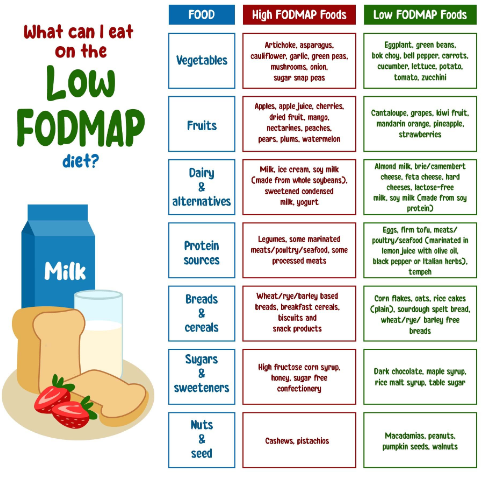BOURSESSENEGAL – The FODMAP diet has gained immense popularity among those seeking relief from digestive issues. This low-FODMAP approach aims to identify and eliminate certain carbohydrates that can lead to discomfort. Whether you suffer from irritable bowel syndrome (IBS) or other digestive conditions, understanding the FODMAP diet can help improve your quality of life.
What is the FODMAP Diet?
Understanding FODMAPs
FODMAP stands for Fermentable Oligosaccharides, Disaccharides, Monosaccharides, and Polyols. These are short-chain carbohydrates that some people find hard to digest. Common FODMAPs include:
- Oligosaccharides: Found in foods like wheat, garlic, and beans.
- Disaccharides: Primarily lactose, which is found in dairy products.
- Monosaccharides: Fructose, often present in fruits like apples and honey.
- Polyols: Sugar alcohols like sorbitol and mannitol, found in certain fruits and artificial sweeteners.
When these carbohydrates aren’t fully absorbed in the small intestine, they can ferment in the gut, causing gas, bloating, and other uncomfortable symptoms.
Why Follow a FODMAP Diet?
Many people experience digestive symptoms due to FODMAPs. The FODMAP diet helps identify which of these carbohydrates trigger your symptoms. By eliminating high-FODMAP foods, you can reduce discomfort and improve overall digestive health. This diet isn’t just about restriction; it’s about understanding your body’s reactions and making informed choices.
The Phases of the FODMAP Diet
1. Elimination Phase
In the initial phase, you remove high-FODMAP foods from your diet for 4-6 weeks. This gives your gut a chance to heal and symptoms to subside. During this time, focus on low-FODMAP alternatives. Some options include:
- Gluten-free grains like rice and quinoa.
- Most meats and fish.
- Lactose-free dairy products.
2. Reintroduction Phase
Once you’ve completed the elimination phase, gradually reintroduce high-FODMAP foods one at a time. This process allows you to identify which types of FODMAPs you can tolerate. Keep a food diary to track your symptoms and reactions. This phase can take several weeks, so be patient.
3. Personalization Phase
The final phase involves creating a long-term, balanced diet based on your individual tolerances. You may find that you can enjoy certain high-FODMAP foods in moderation. The goal is to expand your diet while minimizing discomfort.
Common Misconceptions about the FODMAP Diet
“The FODMAP Diet is Just Another Trend”
Many people view the FODMAP diet as a fad, but research supports its effectiveness. Studies show that individuals with IBS experience significant symptom relief when following this diet. It’s a well-established approach in the medical community for managing digestive issues.
“It’s Too Complicated”
While it might seem overwhelming at first, the FODMAP diet becomes easier with practice. Numerous resources, including apps and books, can guide you in meal planning. Over time, you’ll learn which foods work for you, simplifying the process.
“I’ll Have to Avoid All Carbs”
This misconception stems from the restrictive nature of the elimination phase. While some carbohydrates are off-limits initially, many low-FODMAP options remain. You can enjoy a varied diet rich in nutrients without sacrificing flavor.
Tips for Success on the FODMAP Diet
Meal Planning
Planning your meals is crucial when starting the FODMAP diet. Make a weekly meal plan that includes a variety of low-FODMAP foods. This prevents boredom and ensures you receive balanced nutrition.
Reading Labels
When shopping, always read food labels carefully. Many packaged foods contain hidden FODMAPs. Look for lactose-free, gluten-free, and low-sugar products to stay within your dietary guidelines.
Mindful Eating
Practice mindful eating by paying attention to your body’s hunger and fullness cues. This practice can enhance your overall relationship with food and improve digestion. Chew slowly and savor each bite, which can help your body process food more efficiently.
Low-FODMAP Recipes to Try
Breakfast Ideas
- Overnight Oats: Use rolled oats, lactose-free yogurt, and blueberries for a nutritious start to your day.
- Smoothies: Blend spinach, banana (unripe), and almond milk for a refreshing drink.
Lunch Options
- Quinoa Salad: Combine quinoa, cherry tomatoes, cucumber, and a drizzle of olive oil for a light meal.
- Grilled Chicken Wrap: Use a gluten-free wrap filled with grilled chicken, spinach, and a low-FODMAP dressing.
Dinner Favorites
- Stir-Fried Vegetables: Sauté bell peppers, zucchini, and carrots with garlic-infused oil for a tasty side dish.
- Baked Salmon: Serve with roasted potatoes and steamed green beans for a balanced dinner.
The Role of a Dietitian
Consulting a dietitian experienced in the FODMAP diet can be incredibly beneficial. They can provide personalized guidance, help with meal planning, and ensure you meet your nutritional needs. A professional can make your journey smoother and more effective.
Conclusion: Embrace the FODMAP Diet for Better Health
Adopting the FODMAP diet can lead to significant improvements in your digestive health. By understanding which foods work for your body, you empower yourself to make better dietary choices. Remember, it’s a journey—take it one step at a time. With dedication and patience, you can enjoy a fulfilling and symptom-free life.
Incorporating the FODMAP diet into your lifestyle can transform your approach to food. By learning about FODMAPs and discovering how they affect your body, you take control of your digestive health. Don’t hesitate to seek support from professionals to enhance your experience. Embrace this opportunity to feel your best!
REFERENCE : https://www.health.com/



